|
FAQs on the Combtooth Blenny Identification
Related Articles:
True or Combtooth Blennies,
Algae Eating Blennies,
Ecsenius Blennies, Sabretooth Blennies, Family
Blenniidae/Tribe Nemophini, Tube/Pike/Flag Blennies/Chaenopsidae,
Related FAQs:
Algae Eating Blenny (AEB) Identification,
Combtooth Blennies 1, Combtooth Blennies 2, Blenny Behavior, Blenny Compatibility, Blenny Selection, Blenny Systems, Blenny Feeding, Blenny Disease, Blenny Reproduction,
Algae-eating
Blennies, Ecsenius Blennies, Saber-Tooth Blennies, Blennioids & their Relatives,
Tube/Pike/Flag
Blennies/Chaenopsidae,
|

|
|
Blenny ID? 1/24/19
Hi Crew,
Can you please help in IDing this Blenny? Looked like a Hypsoblennius to me.
<Do agree w/ the genus; but the species?... Have you searched on Fishbase.org
re? Bob Fenner>
|
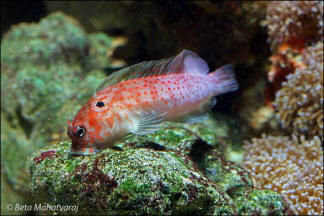 |
|
Re: Blenny ID? 1/24/19
Thanks Bob. I haven't checked FishBase. Shall give it a shot.
<Yes; this is the route I would go. I quickly looked over the Google 'pix'
online, and some ref. works I have next to my desk here.... But the real/next
step would be to put in the genus Hypsoblennius, and click on each species
Fishbase.org brings up to see the images, distribution.... BobF>
|
|
Re: blenny ID question of 12/25/15
1/24/16
Hi Bob!
Hope you had a great vacation!
<Thank you Kittie>
Attached is a recap of the first pic I sent along with the now pic of "Gobe" my
Blenny. I have done a Google search and image search, also mined thru
your site trying to obtain a true ID of "Gobe". I have found spots and stripes
and horns but not in the correct combination. As he has aged his spot and fin
stripe have changed little, as you can see his body coloring
is quite different he is still possessed of his Jiminy cricket style horns and
has grown to about 2 - 2 1/4 inches. His behavior has changes also.
Early on it was hiding in shells or swooshing sand at the base of a single
structure, now my tank looks like a WWI battle ground, pits, divots, holes,
toppled ric-rack and I swear the little guy has a grin on his face all the while
he's excavating! He is getting a bit more aggressive to any new comers to the
tank, he also seems to recognize me ( at feeding time)! Do you have any more of
an idea what he is?
<Mmm; no... Can you tell me; do you know where this fish was collected?
I'd go thence to Fishbase.org, look up by country, island... then re-sort by
family (Blenniidae likely)... and pix of what they have for the area...>
I have looked up images of the initial ID and he just doesn't quite look the
part. In the first post you mentioned a reference tome that you consult, could
you please give me the title and if you know of a place that I could find a
copy, perhaps a reasonably priced older copy?
<Please re-send/send our prev. corr. There are MANY ref.s>
Thank you for taking the time in answering not just my post but in providing
answers to a vast number of questions and information that is easy to understand
but hard to locate on ones own!
Sincerely,
Kittie
<Be chatting! Bob Fenner>
Re: blenny ID question of 12/25/15... an algae blenny!!!!
1/24/16
Hi again Bob!
I have pasted our first conversation below. The exact location of the
Sargassum that contained "Gobe" was in the ICW barely south of the Jupiter, FL
inlet.
<Ahh! Looked through Humann/DeLoach works, Mickey Charteris... then finally the
routine I'd mentioned last time (on Fishbase)...>
I have looked in the various Florida fish ID bases and Caribbean, it is very
frustrating, there are so many slightly varied fishes,
<This species is HIGHLY varied!>
and unfortunately I am, shall we say a tad bit OCD about not letting go of
something until I have an answer! Needless to say I am insane most of the time!
:)
Thank you,
Kittie
<Am almost sure this is the fish:
http://fishbase.org/photos/ThumbnailsSummary.php?Genus=Parablennius&Species=marmoreus
Bob Fenner>
|
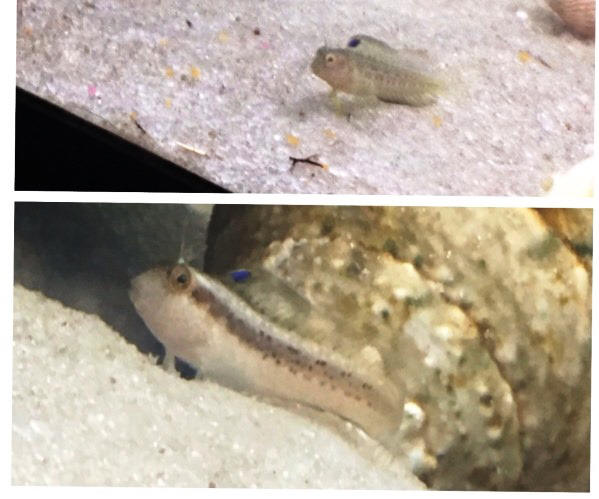 |
|
Re: Fish ID. 10/8/14
Thank you. Here's a bigger pic of the blenny. It's a sand pic just higher
resolution. I've been told that it's a Petroscirtes mitratus.
<I'll go w/ this guess>
My LFS has one in stock but listed it as "assorted blenny". I figured I
would do my due diligence before pulling the trigger. Thank you for your
help.
<Welcome. BobF>
|
 |
|
Fish ID and a little Info
6/4/14
I was speaking to Bob on FB today asking him for some help on this fish.
It is a Red blenny in my eyes. Let me know your thoughts please
regards,
Marlon
Global Oceanic Life
www.globaloceaniclife.com
<Ah yes. Thank you for sending this on over Marlon. This fish is the
notorious Exallias brevis (Kner 1868), Leopard Blenny... A real bad-boy that
though gorgeous IS an obligate
coral polyp eater. Shouldn't be sold in the trade. Have spent many an
hour in Hawaii waiting for a good composition with these so and so's while
they perched and dived on Poritids! Cheers,
Bob Fenner>
|
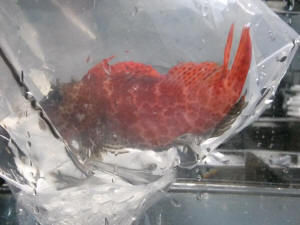
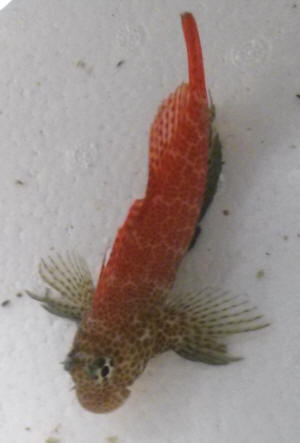 |
|
Blenny... which species? 4/24/13
Hi.
I have a flame tailed blenny.
<... is this Ecsenius bicolor?>
I was looking online and i cannot find any info that is solid.
<...? Much written on this species; including its husbandry>
I'm truing to find out hot to tell if it is a male or a female.
<In a group by size, colour (more brilliant in males) and
behavior/dominance>
And it seams like most people cant tell the difference between a flame
tail and a bicolor.
Is it the same fish?
<.... Can't tell from here. Common names won't get you an answer.>
I want to get a mate for mine and i don't want to get a wrong fish.
Thank you.
<Determine the species you're interested in/dealing with. Bob Fenner>
Re: Blenny
<Is it full moon time again? Seven megs of pix...>
That's the problem. All I got is that its a flame tail blenny.
I don't know how to tell the difference.
Here are some pictures. Maybe you can tell which one it is.
<Mmm, well; some folks list this as an Ecsenius sp., others as an
Atrosalarias, but I believe it's Enchelyurus flavipes
BobF>
That's the best pictures I could take.
|
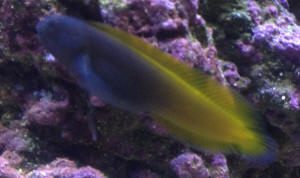 |
Re: Blenny
4/25/13
Ok. But the question remains.
Where do I go for information about it?
<Mmm, likely for the sorts of info. you're looking for, the Net, hobbyist
groups/bb's, rather than books, journals. There's a couple of articles re
how to do these searches archived on WWM>
Is it normal for it to look like it is pregnant?
<If overfed, yes. Blennies in general are "eager-eaters">
Whats is the difference between the ones you mentioned, and how do I tell
apart male from female? (If it is possible)
<... I've already mentioned this>
How can I stop it from begin such a pain when it comes to cleaning crew?
<...? Can't really>
It was nipping at the mex turbo snails.
I traded those fir more hermits.
Today I saw it yank a hermit out of a rock.
Not sure if it tried to eat it but the result was that the hermit made
several summersaults and landed about 6 inches away.
I did not see any limbs missing, but than again they aren't easy to count.
For all i know it might have been helping the poor hermit with his swimming
lessons.
<Heeeeee!>
I want to keep it because it is funny.
(Especially when it plows through other fish to get to some food.)
And at the same time I don't want the other tank mates to suffer.
<Better tankmates. B> |
Enigmatic Blenny, ID, and incomp. w/ stony corals
2/15/13
Hi guys,
<Robert>
I have a couple of inter-related questions. First, the background:
a local friend of mine (Mike) is a clownfish breeder who shares my habit
of keeping fish in mated pairs. He acquired a pair of blennies
from another local hobbyist who had actually collected them in
Galveston, Texas. (We go down there in the summer to get peppermint
shrimp).
<Have done this as well... There and Port Aransas, with hobby groups>
This pair of blennies laid eggs, Mike raised them on rotifers, and now
he has a number of pairs of them he's been distributing to fellow
breeders. I believe he said that Matt Pedersen told him he was
likely the first person to rear the species in captivity.
<Neat!>
But we don't actually know what species it is! So, the first question is:
is this just a molly miller or a horned blenny, or is it something we
can't find in our research? (I'll post links to pictures on breeder
websites below).
<Will take a look>
Second question: Is it possible that these blennies eat coral polyps?
<To some extent, yes>
I took a pair of them home and put them in my 75g SPS-dominate reef.
They share their new home with a pair of Tiger Wardi gobies, a pair of
Banggai cardinals (I recently raised a batch of their babies!), a pair
of Lubbocki wrasses, a cleaner goby, a fat cleaner wrasse and a fat
reef-top pipefish who eats the dreaded "red bugs" (I witnessed it!).
After having the blennies in the tank for a couple days, I watched
horrified as the bigger blenny hopped over to my only Acanthastrea
echinata (LPS corals are too expensive for me), and took a nibble!!!
I told myself that the blenny was probably picking algae off of the side
of the frag plug, but then I watched
the blenny do it again the next day! The Acan coral is now
receding rapidly and I expect it to die.
<I'd cover it with a plastic, perforated structure (like an inverted
strawberry container)>
Last night I watched the blenny hop over to an unknown species of
small-polyped stony coral (which happens to have long, bushy polyps) and
take a bite at the coral flesh.
<Yikes... may have to be moved elsewhere>
The blenny took a bite in an area where there is definitely ONLY coral
tissue/polyps. Not near the base of the frag, but on a bushy
branch. Then, the blenny hopped over to my beloved Acropora yongei
(aka "Green Slimer"), and took a bite at the branches. (again, only
coral tissue in the area, no dead spots with algae growing).
So, my concern is: 1) is this a Molly Miller blenny;
<The one shown here:
http://www.marsh-reef.org/marine-reef-general-discussion/33506-eggs-5.html
eighth input down is; but the pix on the video linked below appear to be
something completely different.>
2) is it possible that there are evil cousins to the Molly Miller blenny
who live in Galveston and prefer to eat expensive corals?;
<Apparently so>
3) Is this fish just "trying out" coral polyps and will it continue to eat
them?
<Too likely will continue>
I feed the tank Mysis once a day (twice per day since I witnessed the
polyp-eating) and pellets a couple of times a day. The blennies
were raised in a small breeder setup and only saw slime algae and one
live rock before arriving in my tank.
References:
A link to a thread on the Marine Breeder Initiative's website: (contains
multiple videos of these fishes' parents and siblings)
http://www.mbisite.org/Forums/tm.aspx?&m=70985&mpage=3
<The video... 7/10/11 by Mike... Is this your fish?>
A link to the discussion on the fishes' origin/collection:
http://www.marsh-reef.org/marine-reef-general-discussion/33506-eggs-5.html
Hopefully you guys will find this interesting! Perhaps one of you is a
resident "blenny-expert" :) I do love blennies and would hate to
have to remove the pair in my tank.
Thanks,
Lee
<Please do send along your best well-resolved images as direct
attachments. Bob Fenner>
Re: Enigmatic Blenny 2/15/13
Hi, this is a follow-up email to the one I wrote below. Apparently
Matt
Pedersen (prominent hobbyist/breeder) identified the blenny in question
as *Hypleurochilus geminatus*
<http://www.fishbase.us/summary/speciessummary.php?genusname=Hypleurochilus&speciesname=geminatus
>
<Ahh! My guess was in the same genus, but tentatively H. caudovettatus.
BobF>
|
Mystery Blenny ID Question (please please please!)
11/16/11
Hi guys,
<Jane>
Just a quick question for you (I hope)! Do you know what type of
blenny this may be?
Pics are attached.
<Mmm>
I've Googled it every way I can think of, searched Fishbase
and turned over every stone I can find. The closest matches I can
find are the Brown Combtooth Blenny (Atrosalarias fuscus) or the
Great Barrier Reef Blenny (Ecsenius stictus), but the pics of
those still don't really look like the fish I have.
<Don't think this is either of these, nor a member of
either genus>
I have two of these guys - they originally came from the same
sandy tidal rock pool,
<A good clue>
along the coast of northern Western Australia (eastern
indo-pacific).
<And this>
Their overall body colour ranges from a solid dark bluish or
pinkish tan though to almost white, depending on their mood or
the time of day.
<Ah yes>
Sometimes they look slightly dotted and mottled around the dorsal
& tail end, but never as pronounced as, say, a Lawnmower or
Algae blenny's pattern. They have no visible horns
either.
<Agreed>
They don't have a dark "chinstrap", like the Great
Barrier Reef blenny does - just a bunch of faint lines across a
pale chin/gill area. Their most obvious feature is that you can
always see those bright incandescent blue stripes over their body
and tail, in wavy vertical lines, and they have blue glowing tips
to all of their fins. I can't find anything which describes
that sort of incandescence for a blenny (but maybe it's so
normal that no one mentions it?
<Perhaps>
- these are the first blennies I've looked after, so I
don't know).
They have plain brown eyes with a black iris - no fancy stripes
or "eyelashes" like some varieties have.
Their behaviour is apparently pretty typical for a blenny -
playful, curious, bold, lots of hiding in holes with head
sticking out, etc. I've had them for about 8 months, and they
were both the same size - about 1 inch long - when they arrived.
I had to separate them after a couple of months as one started
bullying the other. The bully grew much faster (is about
2 inches long now) and the passive one is about
1.5 inches.
<Ahh, still small... or maybe this is just a small
species>
If you can help me out with a positive ID I'd love it - these
guys are going to be with me for a long time yet and it's
agonizing still not knowing what they are (after 8 months of
searching!)
Thanks so much
Regards, Jane
<Have been looking... from your ecological description, and my
pix/remembrance of Hawai'i's similar habitat Istiblennius
zebra had thought this might be a Istiblennius
sp.. But the pix and descriptions I am finding don't
match... Might be an Omobranchus species...
Again, maybe the coloration, lack of cirri are a function of the
juvenile status of your specimens. Please send along your
observational notes and photos of these when they're a bit
larger. Bob Fenner>
|
|
 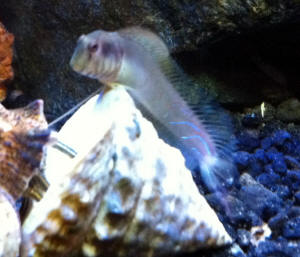
|
|
Re: Mystery Blenny ID Question (please please
please!) 11/17/11
I certainly will Bob. Thanks so much for the info and tips!
I'll do some more hunting on Omobranchus &
Istiblennius.
<Good>
Will keep track of any changes to these little guys over
the next few months, and let you know if they suddenly
sprout horns or something :)
<Heeee!>
Just for fun I've attached another pic of the smaller
blenny, taken this morning, as today it (he?) is putting on
quite a different color show for us. He's showing his
mottling very clearly - brown & tan - and his usual
blue incandescent streaks and fin-tips are barely visible.
His face is yellowish instead of the usual bluish-pink, and
his eyes have turned an orangey colour. A glowing neon
green spot has appeared on his head behind his eyes as
well. Must be feeling in the mood for a party today!
<Sure looks like this is so. Very nice images of
beautiful specimens>
The larger one has been consistently pale tan-to-white all
over in recent weeks, but I think that's just a
camouflage thing as he's over in a different tank with
white gravel instead of black.
I'm guesstimating they may be about 10-12 months old
now... Lifespan of a blenny is, what, around 3 to 5 years?
so they're still just teenagers really :)
<I do think you're right>
I'll get back in touch in a few months after
they've grown up some more, with pics &
updates.
<Thank you. In the meanwhile I may send your images to
systematic ichthyological friends for their input>
Thanks again - this site is an incredible resource for so
many people and we'd be thoroughly lost without you
guys
Regards, Jane
<And you, BobF>
|
|
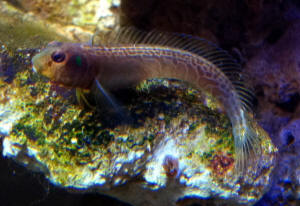
|
|
|
Help me Identify this Blenny -- 04/02/11
Hello,
He was sold to me as a pink spotted goby. But I think he's a
blenny, not a goby.
<Agreed>
I haven't been able to find a picture of this fish any where,
not even in fishbase.org, so I'd like some help identifying
it.
Here are the pictures I have, this is a salt water fish.
Because of the lighting in the tank, he looks different in some
pictures.
His color to my eye though is like this.
<I think this may be Exallias brevis; at any length, it's
starving to death, won't likely live>
His head is golden with pink design on it, not spots, more like
the design on a Discus really. Then his eyes are not starry eyes,
they are just normal eyes. He has cirri? On his nose, above his
eyes and where his head meets his back. His body is a light
lavender color, with pink spots scattered all over it. (no bars
at all). A few of the spots are like tiny dashes, but most are
dots. And they are not in rows either.
His fins are beautiful! The front one has a tall part, then
tappers down, it s a pale pink and the back top fin is a nice
Rosie color, like his spots.
His bottom fin is almost a blue/purple! And his tail has a little
bit of the gold color from his head on it, but is otherwise also
rose colored.
<Mmm, do see WWM re: http://wetwebmedia.com/trublennies.htm
Bob Fenner>
Re: Help me Identify this Blenny -- 04/02/11
Hi Bob,
You have no suggestions on what to try to feed him?
<... see the Net... an obligate corallivore. Doomed almost
always in captivity. BobF>
Thanks,
Mandy
re: Help me Identify this Blenny
Also, if I Google Exallias Brevis, this fish looks nothing like
any of the
Google images that come up.
Is that because it is a juvenile? Or could it be something
else.... Even
the
top find is not the same shape.
<... could be something else... or aberrant form, juvenile...
B>
<Mmm, maybe Cirripectes fuscoguttatus...:
http://www.fishbase.org/summary/SpeciesSummary.php?id=4390
B>
|
|
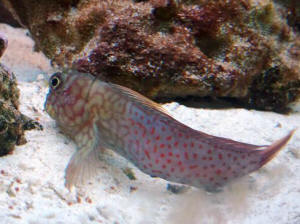
|
|
Here he is... -- 04/02/11
Cirripectes imitator Williams, 1985
Imitator blenny Catalog of Fishes (Gen., sp.) | ITIS | CoL
Classification Actinopterygii | Perciformes | Blenniidae
Advertisement
You can sponsor this page
Upload your photos and videos
| All pictures | Google image |
Hi Bob,
Here he is, Cirripectes Imitator, looks exactly like him.
But they don't say what he eats.....
Thank you though, I never would have found him there without your
pointing me in the right direction.
<Ah, welcome. BobF>
Re: Help me Identify this Blenny -- 04/02/11
Hello once more....I'm sorry to bother you again, but now
that I need to feed him, where do I find that?
I found that he is an Benthic Algae Eater. What is benthic
algae?
<On the bottom, as in attached>
Thank you,
Mandy
<Likely plenty of healthy live rock will do here. BobF>
Another mistaken identity. -- 04/03/11
Dear Bob, I think once again, I was incorrect.
<Oh?>
I think he is a Red Streak Blenny (also called a Scarlet Spotted
Blenny and an Ember Blenny).
<Mmm, Cirripectes stigmaticus? Highly likely the right
genus>
Mine is lighter in color, and smaller than the picture below my
picture, but I think they are basically the same Blenny. It says
that males change colors a lot during sexual periods. I think
mine doesn't have the mature markings on the body
yet....that's why it looks like completely unorganized spots
and dashes.
This is the one I have, the second is off a website that has a
pretty good article on them.
And he's not really rare,....LiveAquaria has them for sale.
But they are a lot like Mandarins, they eat copepods and micro
algae. They are an Omnivore, unusual for Blennies, the website
says.
I met a woman online who has one too, and her's is older and
much darker, and bigger. And she says it was hard the first week
to get him to eat, but after than he's done well. She told me
some of the foods she gets.....she buys Tigger Pods, and a frozen
cube for vegetarians. And something that comes from
Ron's?
<Perhaps "Rod's"... http://www.rodsfood.com/
She's in CA, so they may not have that here in NJ.
<Mmm, look around... if not LFS', then etailers
will>
Sometimes he'll eat a little of the algae sheet, but not
often.
So I just ordered from www.Livecopepods.com Copepods, 3 different
kinds in one bottle, and a bunch of algae for a refugium.
Phycopure Premium LIVE Phytoplankton - 16 oz.
<Mmm, won't eat the latter... DO look on the Net further,
try other foods...>
And their MINI-REFUGIUM COMPLETE kit, has algae and copepods
etc....in it.
I will just put all that in the tank and see if it helps. If
he's still alive when it gets here in two days. Wish us
luck.
<Again, healthy live rock is your best bet at providing
sufficient foodstuffs>
He/she is just beautiful, but his tummy is really tucked up. I
feel so sorry for him.
<I too>
Thanks again,
Mandy in NJ
<BobF (currently) in OC, CA>
|
|
blenny ID question 12/29/09
Hello,
<Hi there Eric>
I was looking to confirm the ID of some blennies I recently got,
and came across your excellent online FAQ. These were labeled as
molly miller blennies at the store, but I'm not really even
sure they're both the same species. Would you be able to help
me out at all?
<I do think these are Scartella cristata... one showing male
breeding colour... the reddish head. Generally peaceful, these
may chase each other about a bit if in the same system...
Hopefully more than 40 gallons in volume. Enjoy! Bob
Fenner>
Thanks,
Eric
|
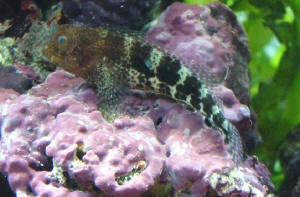
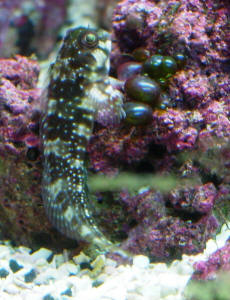 |
Re: blenny ID question
12/29/09
Hi,
Yep, they're in a 75 gallon tank, seem to be getting along just
fine.
Thanks!
-Eric
<Ah, great! Cheers, BobF> |
|
Tribal Blenny (soon to be on Survivor TeeBee?)
ID 12/21/2009
Hello,
<Howdy>
I've just recently obtained a "Tribal Blenny".
I've found that it is a relatively new fish to the hobby and
I am having trouble finding its taxonomic nomenclature. It is an
algivorous blenny and one website says it is collected off of Sri
Lanka. I've found one online vendor that labeled it simply as
Atrosalarias sp..
<Mmm... have seen this (mis)labeled as Atrosalarias namieyi...
and even I believe misplaced in the genus Ecsenius:
http://wetwebmedia.com/blenidfaqs.htm>
The genus Atrosalarias, of course, contains A. fuscus, the black
Sailfin blenny. My tribal blenny does resemble some photographs
of black Sailfin blennies but it seems to be markedly different.
Most noticeably, it has bright blue markings on the face and body
that are always present (not just when exposed to light,
stressed, or photographed). (I will include several photographs
as attachments to this message. The photographs were taken
without a flash.)
If you could assist me in properly identifying what species the
tribal blenny is, I would greatly appreciate it.
Thank you for you time.
Merry Christmas,
Ian
<I don't know, don't see this fish on the Net in
reliable ref. or in my in-print works. My present best guess is
that it is a color variant (geographical form) of Atrosalarias
fuscus. Let's put on WWM and see what folks say. Bob
Fenner>
|
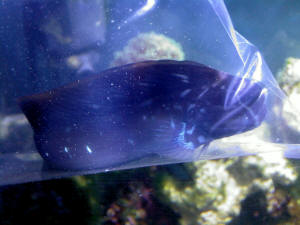 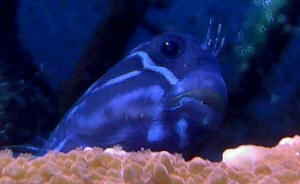 |
|
Re: Tribal Blenny 12/22/09
Hello Bob,
<Welcome Ian>
Thank you for your prompt reply! I have been leaning towards it
being an Atrosalaris fuscus color variant as well. I will post it
on the forums as suggested.
<I have done so on WWM already>
Unfortunately, I've noticed that in addition to grazing on
turf algae, my tribal blenny has nipped at my red Montipora
capricornis. Of the many SPS corals in my tank, this is the only
one he has seemed at all 'interested' in (possibly
because it is nearest to the crevice that he frequents).
<May well be>
I've moved the coral and I haven't seen him go near it
for a while. I really hope this is not to be a common occurrence
as I really enjoy this fish.
Thank you again for your assistance!
Ian
<Certainly welcome. BobF>
Re: Tribal Blenny, ID
and now comp. f' 12/23/2009
Hello again Bob,
<Ian>
I thought I'd give you an update on the tribal blenny as per
its SPS nipping. Unfortunately it has really damaged one of my
Montipora capricornis. It also took a few bites at a Montipora
digitata. I have various varieties and species of Montipora in my
tank and also a few Acroproa, Anacropora, miscellaneous LPS,
miscellaneous soft corals, and a Tridacna crocea clam, among
other things; Of these specimens, the blenny only nipped at two
colonies (the M. capricornis and M. digitata). However, I
certainly did not give the blenny time to become interested in
any other
corals.
(After tearing apart my tank to catch it) The blenny is now in a
small holding tank. I will return it to the reputable vendor I
purchased it from.
I would like to set up a specialty tank (without SPS corals) for
this fish, but I do not have the means to do so at this time. The
coloration and demeanor of this fish are exceptional.
<A happy fish... perhaps if you had a huge system with lots of
Montiporas... it wouldn't be damaging too many>
Regardless of these happenings, I am still very interested to
discover the exact taxonomy of this blenny. Please keep me
informed. Thank you!
Merry Christmas,
Ian
<We accrue all. BobF>
|
|
Unidentified blenny 11/11/09
Hi There! Funny that we've always been able to find the
answer to our questions on the site, and then twice within a week
I have new unanswered questions! My husband netted our mantis
shrimp a few days ago, and we got all of the rock back in, and
water back to perfection, and I set out to restock our tank. I
picked up this blenny at my LFS who had him labeled as a 'red
finned blenny' when I got him home he almost resembled a
leopard blenny because his camouflage was so elaborate. I Googled
and searched WWM for a 'red finned blenny' but with no
results. At first I thought he may be an ember blenny but his
face is different, his eyes don't protrude as much, he
doesn't have any of the filament things on his head and his
dorsal fin is shaped much more like that of Atrosalarias fuscus
fuscus. In fact, his entire body structure is very similar to a
black sail fin blenny. His coloration however is quite different.
First, he changes colors A LOT!
And seems to blend in with his surroundings flawlessly- he is
always very colorful) (If he's sitting on a purple rock,
he's purple, if the rock is orange, he is orange.) He has a
red line that runs the length of the top of his dorsal fin, I
don't see any teeth in his mouth comb or fang, and his dorsal
and pectoral fins are elongated and come to a point towards his
tail. I have not been able to get any good pictures of him yet,
only a blurry one, but I was able to find some images online of a
fish just like him (but without the red line on the dorsal fin)
that was miss-labeled as a horse face blenny. (so, 3 pics: 2 from
the web, 'daytime' and 'night time' and the
blurry on is my fish while in the acclamation process) I really
have no idea what he could be, but if anyone has an answer,
it's you guys! Thanks in advance for the help.
<Is your fish here?
http://wetwebmedia.com/algaeblensart.htm
I think it may be a Salarias ceramensis. Bob Fenner>
|
 
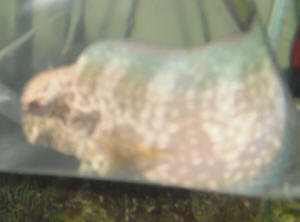 |
Re: unidentified blenny
11/11/09
I had actually checked the blenny page before emailing you (it is
very good by the way) to see if I could find him, and no, I
don't think he is a Salarias ceramensis. The dorsal and
pectoral fins are wrong (look towards the tail) , and my fish's
eyes are set more closely in his head. Also my fish is much more
colorful than a Salarias ceramensis, and can actually be mostly one
color all over, then change to have all the speckles all over his
body. He also lacks any of the filament antenna things that make
some blennies look almost hairy.
<Interesting... and you likely know there are hundreds (about
420) species of true blennies... Maybe take a/the long look on
Fishbase.org re the pix/species:
http://www.fishbase.org/identification/specieslist.cfm?famcode=392&areacode=
Happy hunting! BobF> |
|
"Special" Multicolor Blenny, not
responding... 4/22/09
Hello and thank you for providing the wonderful service that is
the WetWebMedia website,
<Hi Edgar, and you're welcome.>
I recently purchased what I now believe to be a mislabeled fish.
My LFS had it labeled as a Leopard Blenny, but a quick image
search when I got home revealed that it likely is not. It's a
bit over 4" long and a bit thicker than a nickel. I attached
a photo. Any idea what it could be? I've been searching the
net for days and can't come up with anything. Many thanks in
advance,
<I can't find a match either, but likely it's a blenny
from the genus Ecsenius... Bob? <<? James?>>
James (Salty Dog)>
Edgar
<<... it's not me either... This looks like a Jawfish
species (Family Opistognathidae) rather than a Blenny, Blennioid.
RMF>>
|
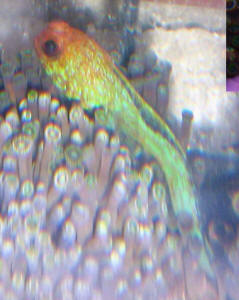 |
|
Mail. Not goby/Jaw ID --
04/22/09
Bob,
Re <<... it's not me either... This looks like a
Jawfish species (Family Opistognathidae) rather than a Blenny,
Blennioid. RMF>>
Believe you called it....now likely an Opistognathus specie,
quite possibly the Chestnut Jawfish. You're the man!
James
<We're the petfish men! B>
|
|
Black Blenny with Blue Spots... ID 03/21/2008 Hello,
<<G'Morning, Andrew today>> I picked up a blenny
today. It was labeled as "Black Midas Blenny w/ blue spots
(Ecsenius midas)". However I haven't been able to find
any information on this fish. <<Read here
http://www.wetwebmedia.com/ecseniusblennies1.htm >> I also
haven't been able to get pictures yet, due to the fact that
as soon as I released it into its new home, it hid and isn't
being cooperative in posing as of yet. <<It will, as soon
as it settles in>> After looking at the site I think the
fish looks most like Atrosalarias or Cirripectes, although I know
that outside appearance doesn't always determine the Genus or
species of a fish. <<True, these do change colour when
stressed>> Any information would be appreciated. Thank you
in advance, Doran <<Thanks for the questions, hope this
helps. A Nixon>>
Re: Black Blenny with Blue Spots 03/23/2008 This
isn't the best picture, but it shows off the blue on the
face. <<Ecsenius namiyei>> I looked at Ecsenius, here
and on FishBase, and I am leaning towards either E. midas
variant, or E. namiyei. I don't know where they originated
but they came to the US from the Philippines area of the
Indian/Pacific Oceans. Thanks again, Doran
<<Thanks for the follow up. A Nixon>>
|
|
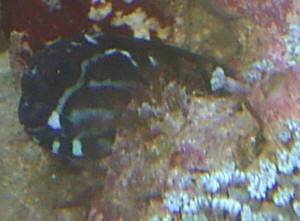
|
| Ga-Ga For His Goby-But It's a Blenny!
11/15/07 Hi there, <Hey there. Scott F. here today!> I
was wondering if you could help me identify my species of goby? I
have searched online and asked at my LFS but cannot seem to find
the exact species. I have attached two pictures above for
reference. Thanks for any help you can give. Mark <Well, Mark-
it's actually a Blenny: Ecsenius stigmatura, the "Tailspot
Blenny". It's an awesome little fish (maxes out at 2
inches or so). Mainly herbivorous, and pretty peaceful, too! I love
'em. They have wonderful personalities and are very good
community fishes. They can get a bit feisty with other Blennies, so
you have to stock carefully, but they are otherwise really great
little fish. Enjoy! Regards, Scott F.> |
|
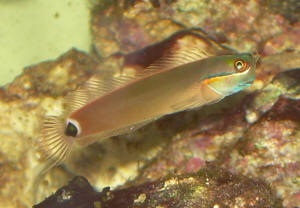
|
Re: Check ID/Feeding of your "Sailfin" Blenny, Before
Purchasing - 03/12/07 <Hi Lance, Pufferpunk here> I'm
confused - I was under the impression that this was an algae eater,
hence the name (lawn mower), it eats algae of the glass and rocks yet
your suggestion is that it only eats "whole-animal foods" so
what is it that I did not research before my purchase? Is this not an
algae eater? <In reference to your previous question about your
"Sailfin" blenny: The "lawnmower" blenny is not the
same creature as a "Sailfin" blenny. 2 totally different
species that eat 2 totally different foods. We can't give you the
correct info, without proper ID. ~PP> Lance
Sailfin Blenny 3/21/07 Sorry for confusion - this is a lawn
mower blenny - I guess some also call it a sailfin but it is definitely
an algae eater <What was the question? ~PP> Lance
Horse Faced Blenny I.D. 3/1/07 Hi guys!
<Hello.> I'm hoping you can help me ID the attached fish.
<Will attempt is very small/blurry.> It was found in the gulf
of Mexico in shallow water off the coast of Texas. My guess is some
species of Scorpionfish maybe? <I do not believe so.> The
person that found and caught it says that it has kind of a red
Mohawk on the top of its head. They have added it to their reef
tank along with a second specimen of the same species that they
have assumed is the female version. <Mmm...not a god idea to
collect and add to display without quarantine or knowing what the
animal is but it appears to be a blenny, specifically Ophioblennius
steindachneri which would fit the geographical area you have
collected it in. As far as having a male and a female, as far as I
know Sexual Dimorphism is not readily apparent with this species,
though Bob will correct me if I am mistaken.> <<I do agree
with your Adam. RMF>> I'm really curious as to what it
is. <See above and search WWM for care re:> Hope you can
help. <A larger picture would be nice but I am fairly certain of
my I.D.> Thanks.
<Of course.>
Ginger
<Adam J.> |
|
 actual size of the graphic sent
actual size of the graphic sent
|
Re Blenny I.D. 3/3/07 Thanks for your reply
on my fish ID. <Of course.> I've attached one more
picture that's a little better. <No.....a lot....better,
thanks.> This one shows him with his "crest" up. Do
you still say it's a Horse Faced Blenny? <Yes.> Thanks
again.
<Of course.>
Ginger
<Adam J.> |
|

|
| Blenny ID 1/17/07 Hey Crew! <"You
EEdiot Schtimpy!"... Uhh, read and follow instructions
please... your too-large image has crashed our email server...
THANKS!> I managed to get a picture of the blenny that I asked
if you could identify for me. As I said before, it's very
elongated, has a light brown under shade with purplish-brown bars
in intervals on its sides. The tail and fins a large and speckled
silver and black. The head has a distinctive rounded crest and two
stripes running from that to about eye level. Besides the ridge it
seems very similar to the Redspotted Blenny (Istiblennius
chrysospilos). The two pictures are attached with the email. See
what you think about it and let me know. Thanks again, George
<Does look like an Istiblennius species... maybe this one:
http://fishbase.org/Photos/ThumbnailsSummary.php?ID=6047
Bob Fenner> |
|
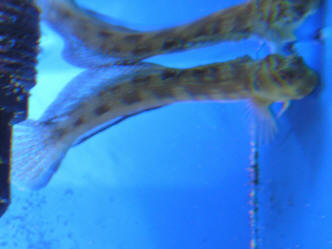
|
Blenny ID 1/14/07 Hi Crew! <Hi George> I recently
purchased a blenny from my LFS that was labeled as an "eyelash
blenny". I know this is a generic name and was wondering if you
could help me identify it. It is long and slinky with a mottled reddish
brown-gray color. It has the characteristic "eyelashes" but
there is a rounded ridge on the top of the head with two vertical pink
bars that run from the top of the ridge to the eye level. Besides the
ridge it seems very similar to the Redspotted Blenny (Istiblennius
chrysospilos). I have already looked at your ID pages and was wondering
if you have any idea of what it could be. <George, identifying a
particular fish from a large family is difficult with just a
description. Is best to send a photo along for an accurate ID.>
Thanks for your time, <You're welcome. James (Salty Dog)>
<<RMF would have sent him to Fishbase.org with the common
name...>> George
Salarias ceramensis Bob, I have checked your site again but
didn't see anything posted. Is your site interested about range
extension for Salarias ceramensis? I can let you have a photo taken at
Heron Island in natural surroundings if you are. Kind Regards Brian
Mayes <No pic needed if you don't want to have it posted,
credited to you. Would however send your range extension information to
fishbase.org. Look up the species and click on the... oh, wait, I see
you already have.
http://www.fishbase.org/Summary/SpeciesSummary.cfm?ID=7749&genusname=Salarias&speciesname=ceramensis
Bob Fenner>
Salarias ceramensis, range extension Dear
Sir, With reference to page http://www.wetwebmedia.com/../trublennies.htm
I photographed Salarias ceramensis at a depth of 10m between
"Pam's Point" and "Heron Bommie" off Heron
Island on 10th Oct 2003. Your web page photograph in an aquarium
and does not mention the range in GBR. With my find, the range has
been extended. Below is a series of emails between me and The
Australian Museum, National Museum of Natural History in Washington
and Paul Humann. At the bottom are a couple of the photographs. I
would be happy for you to update your website with these and the
new information providing of course you correctly credit the
photography and identification. Kind Regards Brian Mayes <Will
post. Thank you for sending this along. Bob Fenner> Hi Brian, I
just saw your forwarded email from Vic Springer further down in my
inbox. I'm delighted that Vic confirmed the identification as
S. ceramensis. I will go ahead and add your image to the current
webpage and update the description of the fish in the text. Yes,
the fish is a range extension! Well done. I will mention this on
the webpage. I'll email you when this is done. Thanks heaps,
your image will really improve the page. Cheers, Mark McGrouther
Collection Manager Australian Museum Fish Section Division of
Vertebrate Zoology Dear Mr. Mayes, I concur with Paul Humann that
the specimen is Salarias ceramensis, and possibly represents a
southern range extension for the species, if it came from the Heron
Island area (I would have to do a lot of checking in order to
verify if it is a range extension). The photo of the specimen
illustrated at the web site you mentioned was taken several
thousand kilometers from where you photographed your specimen. The
color pattern of your specimen is more typical of the species.
Blennies often modify their color pattern to accord with their
"emotional" state, frequently becoming dark or pale when
stressed, which might account for the dark pattern of the web-site
specimen. Thank you for calling the specimen to my attention.
Sincerely, Victor G. Springer Curator, Senior Scientist Smithsonian
Institution PO Box 37012 National Museum of Natural History -
MRC-159 Washington, DC 20013-7012 USA Office: 202-357-3305 Fax:
202-357-2986 email: [email protected] Dear Sirs, I contacted the
author Paul Humann about a blenny I photographed off Heron Island.
He advises it to be Salarias ceramensis. I found your names
credited with the identification of a photo of Salarias ceramensis
on the Australian Museum website at page http://www.amonline.net.au/fishes/fishfacts/fish/sceramensis.htm
. The description and photo on the web site doesn't tie up with
my photos below. I wondered if you agreed with Paul Humann that my
photo is indeed Salarias ceramensis and if this is the case and
mine is a variant, then would you like a photograph Kind Regards
Brian Mayes Subject: Re: Fish Ident. Hi Brian, I've checked
with a couple of people and your mystery blenny is probably
Salarias ceramensis, sorry but there appears to be no common name.
Best "fishes, " Paul Dear Paul, I wonder if I could ask
you for some help. I have been trying to identify a fish I
photographed on a dive off Heron Island, GBR, Australia. It seems
like a type of Blenny but I can't seem to find it in
"Fishes of the Great Barrier Reef and Coral Sea", by John
E. Randall, Gerald R. Allen and Roger C. Steene. Do you have an
email address for any of the authors? Better still can you identify
it? Photographed at a depth of 10m between "Pam's
Point" and "Heron Bommie" off Heron Island on 10th
Oct 2003.
Kind Regards
Brian Mayes |
|

|
Tiger Blenny Hi Guys, <Hi Megan, MikeD here> I've
recently purchased a Tiger Blenny from my local aquarium (am in
Australia) - but can't find out anything about him!!! The most I
have found is a picture, but no useful information! I thought you guys
would have a vast information base, so here I am! Any links, info you
have would be greatly appreciated.<This one is extremely tricky do
to the fact that often each species has many common or
"trade" names, made more confusing by the fact that this
often changes from locality to locality and new trade names are
regularly introduced by ambitions marketers looking for a new angle. If
you found a photo, my suggestion is to look carefully at same and see
if there's genus/species info (the Latin or Greek terms) attached
and do a further search on that basis. While a few members of the
family are vegetarians, the vast majority are predators or omnivores so
you'd probably be safe increasing the protein in it's diet with
shrimp, squid, and crustacean foods (I use the local supermarket
preferentially over the LFS with excellent results)> Thanks very
much, Megan Whall
Vietnamese Blenny? 8/31/04 <Hi, Pufferpunk here>
You guys have an awesome site that has helped a ton in the past and
I'm sure will help more in the future. <Thank you very much!>
Lately I've been hearing a lot about a new brackish fish called the
Vietnamese blenny and actually we just got two at the shop I work at
and it appears to be a neat fish. It's a brown color with some
lighter stripes, and appears to be very similar to the algae
blenny's, although I have not had much chance to observe them yet.
My question is, as I have not been able to find it anywhere on the net
or in any of the books. Could you help me locate the scientific name of
this fish so I can get more info on them. <I have never heard of any
BW blenny's. I think this is probably a SW fish that has been
unfairly acclimated to BW. It probably belongs in SW. Look through the
SW section of WWM site for the ID. ~PP> Thank you very much in
advance, Kyle Woekel. Black Widow Blenny ID I just
purchased what is called a black widow blenny from a friend who owns a
pet store and was wondering if you new anything or could tell me where
I could look , my friend says he's only seen one in his life time
and has nothing in his books. If you could help I would appreciate it
thanks. >> Hmm, this is actually a livebearing Cusk Eel (family
Bythitidae, Order Ophidiiformes)... from the West Atlantic... stays
small (about 3" overall, 7.5 cm. long...) eats most all meaty
foods... easygoing. Fancy name is Stygnobrotula latebricola... sold as
Black Widow "Goby" in the trade... a jumper. You might want
to look on ICLARM's FishBase for what little can be found in the
scientific literature on this animal. Bob Fenner
Name that Blenny! What are some of the common names
associated with Atrosalarias to help me locate them in my LFS? >>
Hmm, Highfin Blenny... Brown or Coral Blenny... many other common names
possible... Take a look at FishBase for pix, species... exp. A. fuscus.
Bob Fenner
Name this fish? :) WWM Group- We bought a fish at the LFS
quite a while ago, we'd never seen the type before but decided to
give it a try. The owner didn't know the name, he thought it was a
blenny of some sort, and had put one in his tank successfully. We
called him the Blue Dragon Blenny. He disappeared recently and we want
to get another one. He had quite a personality. He was a grayish-blue
with antennas, he looks similar to the Black Sailfin Blenny picture on
flying fish express. He was about 4 inches long but we don't know
if he was an adult. He perched, often pushing our hawk out of his
favorite spots, he was also quite the algae eater. We know this is
probably a lost cause but thanks for anything at all. <Hopefully
this is one of the several hundred possible blennies that is commonly
collected. I'll guess it's an Atrosalarias fuscus (come in
different colors). Please see on our root web here:
http://www.wetwebmedia.com/trublennies.htm Is this the animal? Bob
Fenner> Thanks- Elaine
Midas blenny Evening guys, <<Hello, Jason, it's
Jason...>> Just a quick question! I purchased a midas blenny
today, which is already pigging out. <<Good deal.>>
I've been looking at pics of these guys just to get a handle on
their normal and stressed color patterns so I can watch for trouble.
After looking at the images you have posted, are you sure that the
middle photograph (the one immediately to the left of the lyretail
Anthias) is a midas? <<Pretty sure it is, they can vary in color
pretty strongly depending on mood, stress, sleep time and some other
unexplainable reasons.>> It looks more like a canary blenny,
which I have gone well out of my way to avoid! :) Just curious as my
midas does not have the vibrant yellow coloration, and I'm not sure
if that is normal or not. <<Yeah, that's normal... give it
some time.>> Thanks!, Jason
<<Cheers, J -- >>
|
|

